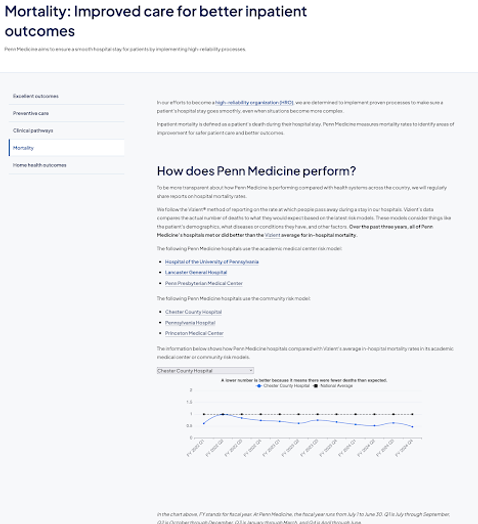Lori Janies
Senior Content Strategist, UX Writer and Content Designer

About me
I have more than 20 years’ experience working as a writer, storyteller and content designer for companies of all sizes, helping them craft the right message for the right audience across industries and channels.
My work
View these select case studies and examples of my digital content design work, each highlighting just some of the many the ways that I infuse content strategy and design thinking best practices into all that I do.
→ Mobile@IBM website redesign and broader brand development: Project lead, content strategist, writer
→ IBM Design Lab cloud computing websites: Content strategy/design/writing/embedded agile team member
IBM intranet
The assignment:
Work with visual designers, developers, UX researchers, project managers, stakeholders and others to provide content strategy, content design and UX writing assistance for the award-winning IBM intranet (known internally as “w3”) whose 350,000+ users depended on it every day.
My role:
Lead Content Strategist for the Digital Workplace Services and Support domain, which includes the w3 team, among many others.

The IBM intranet (known internally as "w3") reached 350,000+ users
Content creation
Wrote UX copy including error messages, on-screen instructions and microcopy as well as longer form content, which required research from SMEs and stakeholders to determine scope and ensure accuracy and rule/regulation compliance. Collaborated on and reviewed designs using Figma.
Content strategy
Developed (and implemented) campaigns to communicate important changes such as the sunsetting of an embedded app, so consistent messages were presented to users in a variety of channels, including banner announcements, emails, executive blogs, FAQs and support articles.
Design thinking and storytelling
Attended regular design sessions with the team to collaborate on
in-process and upcoming work. All user-centric design starts with storytelling—determining who your
audience is, what their information needs are and how to get there.


Before and after: UX dialogs designed to prevent user confusion
The UX content process:
Work on this project typically consisted of ad hoc UX updates (messaging for new features, mobile app updates, iterative functionality changes) as well as larger initiatives (new/redesigned pages, new features, etc.).
Larger initiatives were assigned/documented in Jira and followed iterative agile processes.
For ad hoc UX content needs, I worked hard to build relationships with the design and development teams, so they would come to me directly and consistently for all their UX writing and content design needs. We typically worked over Slack to workshop content needs.
Every change had a defined review chain, with drafts going to multiple stakeholders, including product owners, project managers and executive leadership.
The real-life Slack chat below illustrates the value that a savvy UX writer can add to a digital content project much more clearly than than you could ever glean from simply looking at the subsequent before and after screenshots of the final UX change.



Here are the before and after screenshots of the change being discussed in the previous Slack chat.
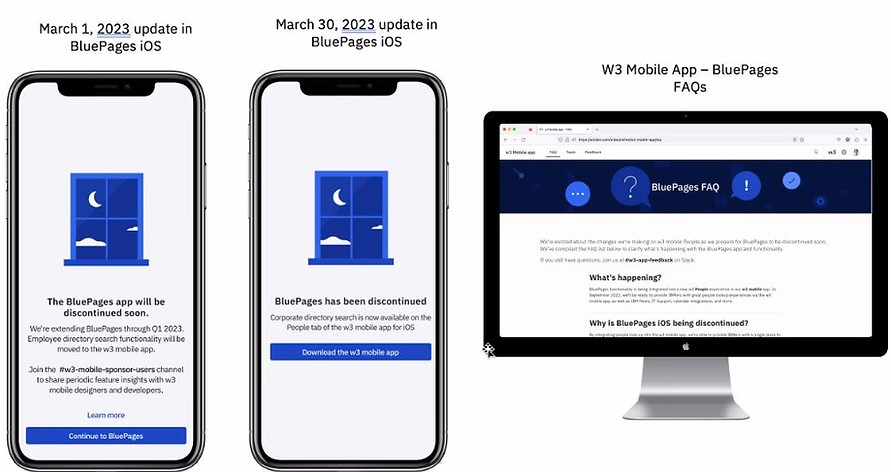
The planned sunset of a widely used and beloved app required long-range UX planning and content design across multiple channels.

Regular feature changes require regular communication with developers, project managers and UX designers, incorporating iterative Figma reviews.

Part of a series of whimsical waiting dialogs for use with equally lighthearted system functions.

UX content defines and is defined by the user journey.
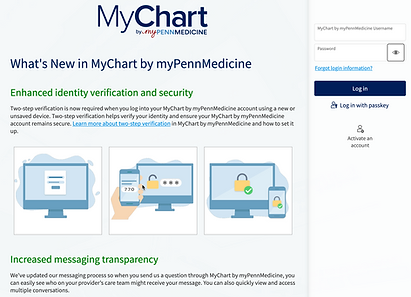
Example: I help provide UX copy for mobile and web interfaces
Penn Medicine UX writing, web content design and marketing writing
The assignment:
Help the Penn Medicine Marketing team with an array of content needs, from designing new web pages to writing UX copy for mobile and web interfaces to being a part of a cross-functional team of clinicians, developers and subject matter experts working to map out the complex processes needed to design an intuitive self-service appointment scheduling experience for Penn Medicine mobile MyChart app users and website visitors.
My role:
Provide writing, content strategy, SEO and UX content support for the Penn Medicine Marketing team and broader Penn Medicine community, as needed.
Content creation
Content strategy
Design thinking and storytelling
Work with subject matter experts to ensure all content adheres to style, and tone guidelines, meets information requirements and is reviewed and approved by all necessary parties.
Help define the unique information needs and goals of each project, make suggestions to improve content design, usability and/or formatting, as needed. Make SEO term recommendations based on guidelines.
Each assignment for this client offers a new opportunity to apply design thinking best practices to the latest set of tasks and to ensure that everything that is created at Penn Medicine is designed to improve the lives and well-being of the patients, employees and communities that the organization serves.

Sample web page template: Web content is entered into one of multiple template types to ensure uniform elements and adherence to standards
Published web page: On this page, visitors can select current mortality outcomes data for various Penn system hospitals using the dropdown list
The process:
The steps below highlight the high-level process for working as a freelancer to meet the content needs of the Penn Medicine Marketing department.
Receive ad hoc task assignment from the project manager.
Determine the unique content goals and requirements for the assignment and ensure that I know what tools are needed to complete the project, what the timeline is, what the criteria for completion is and who must sign off.
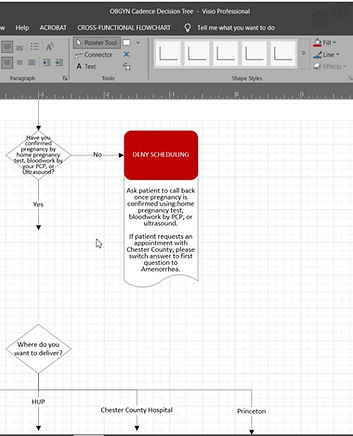
Example: I work with cross-functional teams to help map out processes to design self-service scheduling functionality for Penn Medicine apps and website
Complete necessary work, in phases, ensuring drafts move through the appropriate editorial chain for review and revision, as needed.
Iterate on all steps until all necessary approvals are in place.
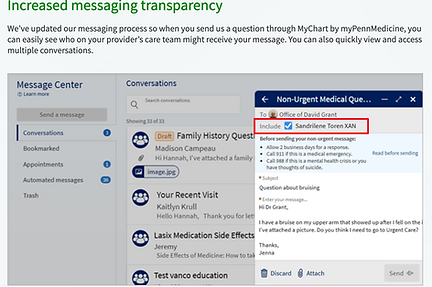
Example: I help provide UX copy for mobile and web interfaces
ServiceNow GenAI content strategy, marketing writing
The assignment:
Work with a dynamic, high performing marketing team to create cutting edge marketing materials about generative AI (Gen AI) technology features being developed for this rapidly growing Fortune 500 company.
My role:
Lead content strategist for a wide variety of projects related to AI and ServiceNow products, including as the Content Experience Team representative for the cross functional Put AI to Work campaign team.
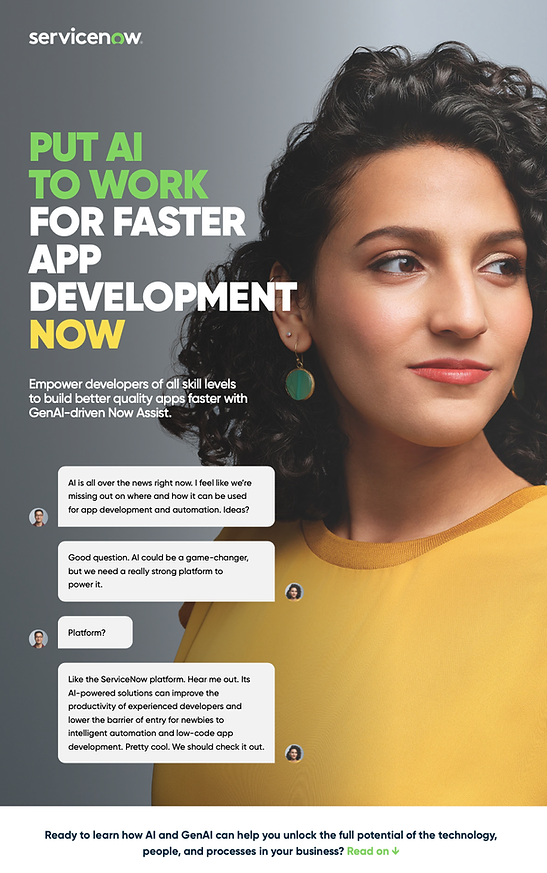
Example Marketing Infographic component
Content creation
Developed creative briefs detailing quarterly writing assignments and helping to inform downstream campaign assets and events. Wrote and edited longform marketing assets related to ServiceNow products and services for distribution across multiple channels. Worked with the Digital team to design and create UX copy for associated campaigns.
Content strategy
Used marketplace and internal metrics to determine what topics to focus on each quarter when planning the editorial cycle, which assets to refresh or retire and which assets to create.
Design thinking and storytelling
Ongoing design thinking and storytelling efforts played a hugely important role on our team to help us ensure our subject matter wouldn't grow stale and that we could continue to differentiate ourselves from our many competitors in an increasingly volatile market.
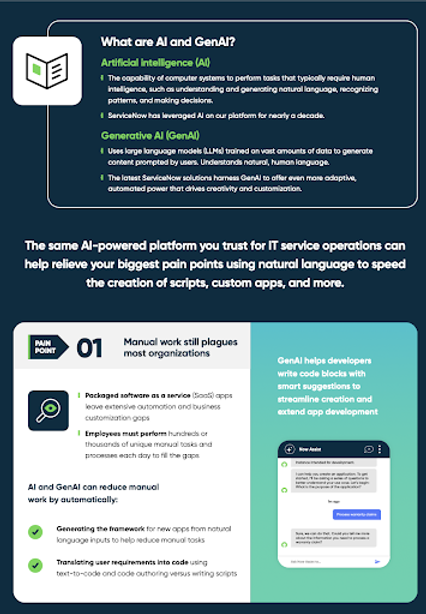
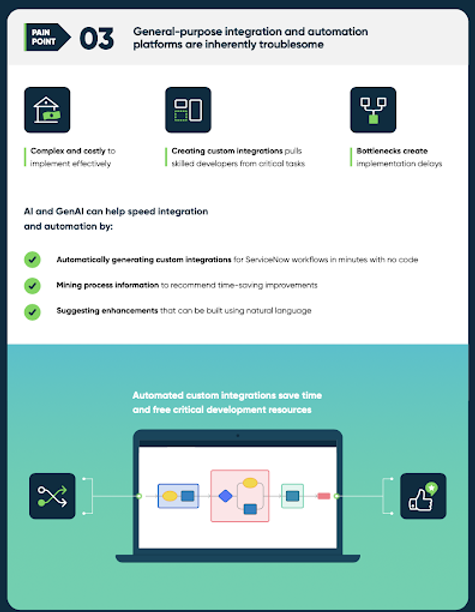
Example Marketing Infographic components
The process:
Work with cross-functional team members and stakeholders to determine content goals, deliverables and timelines for a project or campaign.
Write or oversee iterative drafts of marketing content, ensuring appropriate SEO guidelines are incorporated.
Work with UX designers and developers to review mockups in Figma and provide feedback, as needed.
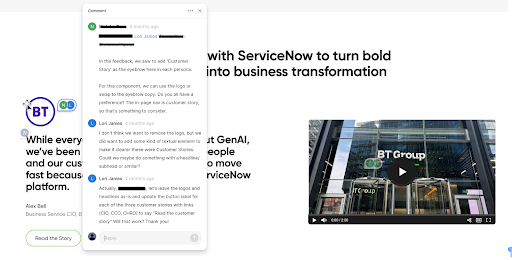
Example Figma collaboration on UX design for a digital campaign element
Track tasks and assets using Adobe Workfront. Publish final files using Adobe Asset Manager.
Mobile@IBM website redesign and brand development
The assignment:
Take a 92-page website with multiple issues (redundancy, broken links, lack of consistency, etc.) and transform it into a concise, streamlined and visually striking site that
offers an exemplary user experience.
My role:
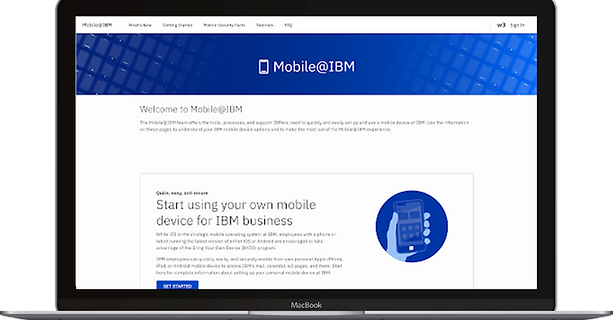

Content Strategist and Content Designer. Worked with a UX and Visual Designer to tear the existing website down and rebuild from scratch. We used an internal web publishing tool, which enabled me to do extensive development work on the site myself.
Content creation
Content strategy
Created (or significantly edited) all the copy on the final site.
Design thinking and storytelling
Our team worked closely together for many months applying good design thinking principles to every step of the process. The original site tried to tell dozens of stories at once and told none of them well. The final product told a single story designed for the users clearly, concisely and elegantly.
This was a massive content strategy project. All 92 of the original pages had to be reviewed and analyzed to determine what was good, incorrect and missing. Developed a new site map. Determined URL naming convention. Worked with stakeholders for review and approvals.


Example work documents
The process:
Analyze the existing Mobile@IBM website and recommend an improved content framework.
The results:
1
Streamlined website
Reduced the content from 92
pages down to 13 pages
Work with the project stakeholders to build a new w3 Publisher site using content strategy, writing, UX, research and visual design best practices in every iteration.
2
Improved Net Promoter Score (NPS)
NPS user satisfaction metric up 13.6 points from the previous year.
Determine optimal URL naming and update strategies, and work with the w3 Publisher team to implement and test necessary back-end changes.
Define and implement MVP and staged releases to optimize value and timeline.
3
Created a design standard
Set the design standard for other @IBM sites, including Mac@IBM and Linux@IBM
"It is truly an art to synthesize detailed, complex topics into digestible and relevant user experiences. The new Mobile@IBM site clearly shows strong empathy for IBMers – a result that came about because of the excellent partnership between the Mobile team and Digital Content Design.”
–Daniele Hayes, Vice President Systems & Tools

Determining how the user journey varied by user locale was a central component of this project
IBM Design Lab cloud computing websites
The assignment:
Design and deliver three websites in a short time period that provide curated, dynamic content about cloud computing to customers in Singapore, India or Australia who access the user experience via targeted email campaign links, paid and organic search terms, and reverse IP lookup.
My role:
Work with UX designers, researchers, developers, other content professionals and multiple stakeholders in a rigorous Agile environment to determine the content needs and
customer journey for each audience, write or aggregate relevant content and test iterative releases before and after publication.
Content creation
Content strategy
Wrote extensive copy related to to all aspects of this complex topic. Content included informational text, infographic components, asset abstracts and
microcopy for buttons, menus and navigational elements.
Design thinking and storytelling
Participated in multiple design thinking sessions with team members and broader stakeholders to map the unique user journeys required for each locale and determine how to present the needed information in the most engaging and effective way.
Helped determine what information was needed and when/how it
should be presented or accessed for each large, information-rich global website.

Spreadsheets of content for dynamic display

Wireframe of draft tab
The process:
The steps below define the high-level process for my role in the curated websites project.
Attend daily Agile scrum sessions and regular planning sessions to define our team’s goals for each two-week
sprint.
Collaborated with UX team members, developers and product stakeholders to continuously iterate on website designs, content and functionality.
Assigned and oversaw the work of other content designers and writers to ensure all content met internal standards and had a consistent tone, look and feel.
Attended regular sprint reviews to present accomplishments to stakeholders.


Iteration of designs

Final website with updated content


IBM sales application with with persona library
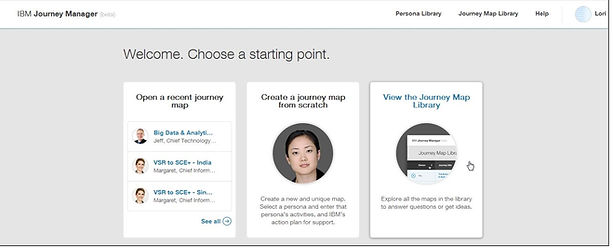
The assignment:
Work with a large, cross-functional design and development team to create (and iterate on) a web-based Journey Manager tool (later renamed to Marketer Workspace) that enabled IBM Marketing and Communications professionals, Digital Marketing professionals and others to visually create a client journey map that facilitates the task collaboration necessary to deploy a client journey in market.
My role:
Work with UX designers, developers, other content professionals and multiple stakeholders in a rigorous Agile environment to define and iteratively deploy this extensive and well-received application. Duties included reviewing wireframes, writing/editing/testing on-screen copy, helping research and create an extensive persona library, and writing release notes, online help and user documentation.

Final content for Journey Manager/Marketer Workspace
Content creation
Wrote microcopy and on-screen instructional content to help users navigate this complex tool. Helped create a template and conducted SME interviews to create more than 100 client personas to populate the tool’s persona library.
Content strategy
Helped determine information gaps within the application and associated assets and outlined how best to fill them.
Design thinking and storytelling
Participated in multiple design thinking sessions with team members and broader stakeholders to help us understand what story(ies) we needed to tell and the best way to
accomplish it.

Final content for Journey Manager/Marketer Workspace
The process:
The steps below define the high-level process for my role in the IBM Journey Manager/Marketer Workspace application project.
Attend daily Agile scrum sessions and regular planning sessions to define our team’s goals for each two-week sprint.
Work with the UX lead to review wireframes for upcoming releases, the visual designer to help with content on imagery and the developers to understand the application design and help test.

Testing a persona
Lead a separate project to identify personas relevant to sales and marketing professionals, find interview subjects to speak to their persona, conduct independent research
to ensure the persona information is complete and accurate, and worked with the developers to add finalized content to the Persona Library.
Reviewed/tested personas once they were in the library to ensure everything was working as designed.
Attended regular sprint reviews to present accomplishments to stakeholders.
General Mills “Champions for Healthy Kids” brochure
The assignment:
Work with company stakeholders to create an engaging, informative and inspirational brochure highlighting winners of General Mills’ Champions for Healthy Kids grants and creatively showcasing how each winning organization will use their grant money to further their efforts in improving the health and lives of children.

My role:
Interview General Mills executives, leaders of the Champions for Healthy Kids grant winner organizations, and winning program participants (kids and organization stakeholders) to determine how each grant winner’s story could best be used to highlight General Mills’ values and community leadership.
Design thinking and storytelling
Content creation
Researched topics, interviewed sources and iteratively created all copy for the brochure.
Content strategy
I had significant input into defining the broader architecture of this site, including where/how to best place content and visuals and what project
components to highlight.
Each segment of this brochure told a unique story, though all the segments needed to build the overarching themes of healthy kids, strong communities and good corporate stewardship. I had extensive creative license to determine how best to tell each story to meet the project’s strategic goals.



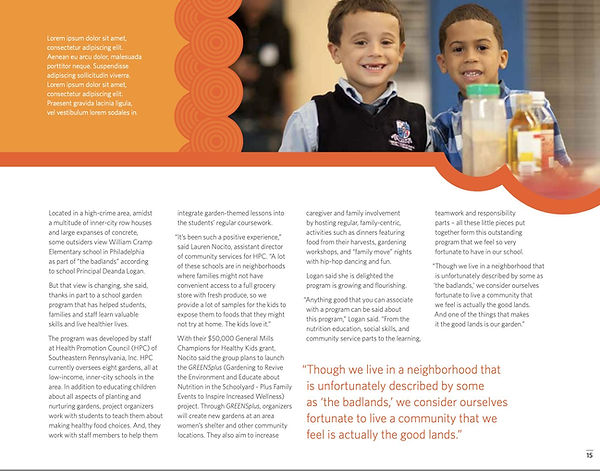
General Mills Champions for Healthy Kids brochure final content
